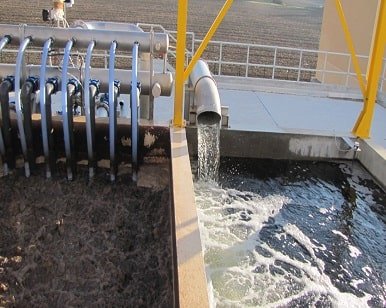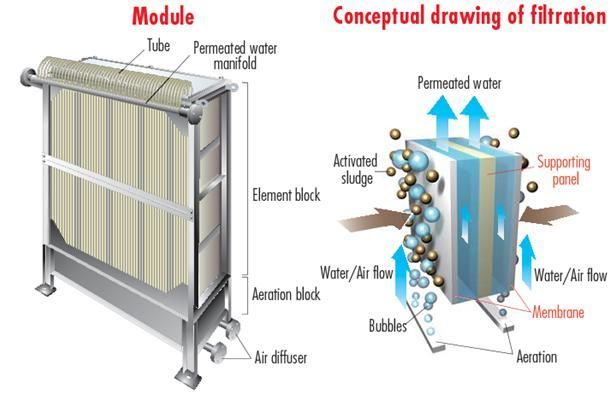The Advantages of Using a Membrane Bioreactor for Efficient Water Purification
The Advantages of Using a Membrane Bioreactor for Efficient Water Purification
Blog Article
Membrane Bioreactors Clarified: Effective Solutions for Tidy Water
Membrane bioreactors (MBRs) have become a sophisticated option for addressing journalism challenges of wastewater therapy. By integrating organic procedures with advanced membrane layer purification, MBRs not just improve the high quality of cured water however additionally reduce the spatial needs of therapy facilities. As ecological issues escalate, the function of MBR technology in advertising sustainable water administration becomes increasingly substantial. However, the intricacies of their procedure, advantages, and possible applications merit a closer examination to completely understand their influence on the future of water treatment.

What Are Membrane Bioreactors?
Membrane bioreactors (MBRs) are advanced wastewater therapy systems that combine biological degradation procedures with membrane layer purification technology. This integration permits the reliable elimination of contaminants from water, making MBRs a preferred choice in different applications, including community wastewater therapy and commercial effluent management.

Among the essential benefits of MBRs is their ability to generate high-grade effluent, typically appropriate for reuse in irrigation or commercial processes. Additionally, MBRs call for a smaller impact contrasted to standard therapy systems, making them perfect for city settings where area might be limited.
Additionally, MBRs can effectively manage differing influent loads and are much less at risk to the effects of hazardous shocks. These features contribute to their growing appeal as a lasting service for attending to the enhancing demand for tidy water while minimizing environmental effects.
Just How Membrane Layer Bioreactors Work
While the operation of membrane bioreactors (MBRs) might appear facility, it fundamentally focuses on the synergy in between organic procedures and membrane layer purification. MBRs incorporate a biological therapy procedure, commonly activated sludge, with a membrane separation system to treat wastewater effectively.
In an MBR system, wastewater is first presented into a bioreactor where microorganisms break down natural matter and other impurities. The organic activity lowers the concentration of contaminants while promoting the growth of biomass. Following this biological treatment, the blended liquor is subjected to membrane filtering, which can be microfiltration or ultrafiltration, depending upon the preferred effluent high quality.
The membranes serve as a physical barrier, allowing water and small solutes to pass while retaining put on hold solids and bigger particles. This allows the system to preserve a high concentration of biomass within the reactor, enhancing the treatment efficiency.
Furthermore, the continual separation of treated water from the biomass promotes a portable layout and lessens the footprint of the treatment center. Generally, the combination of organic destruction and membrane filtration in MBRs causes reliable and trustworthy wastewater therapy, making sure premium effluent ideal for numerous applications.
Advantages of MBR Technology
One of the essential benefits of membrane layer bioreactor (MBR) modern technology is its capability to produce top quality effluent with a significantly lowered footprint contrasted to traditional wastewater treatment techniques. MBR systems efficiently incorporate biological therapy and membrane purification, resulting in premium removal of impurities, including put on hold solids, pathogens, and raw material. This capability brings about effluent that typically fulfills or surpasses rigorous regulatory requirements for reuse and discharge.
Additionally, MBR innovation enables higher biomass concentrations, which boosts the treatment effectiveness and decreases the needed activator volume. This compact style is specifically useful in city areas where area is restricted. The functional adaptability of MBR systems also indicates they can adjust to differing influent qualities and flow prices, making them ideal for a large range of applications.
Additionally, the lowered sludge you could check here production associated with MBR processes contributes to reduce functional and upkeep prices. The membranes work as a physical obstacle, decreasing the danger of obstructing and enabling longer operational periods between cleaning. In general, the advantages of MBR innovation make it an appealing option for sustainable wastewater treatment, attending to both ecological worries and the requirement for effective source administration.
Applications of Membrane Layer Bioreactors
With their adaptability and effectiveness, membrane layer bioreactors (MBRs) discover applications across various industries, including municipal wastewater therapy, commercial procedures, and also water improvement. In community settings, MBRs provide a portable remedy for dealing with wastewater, effectively getting rid of impurities while all at once creating top notch effluent that satisfies strict regulatory criteria. This makes them specifically appropriate for areas with minimal area.
In industrial applications, MBR technology is made use of for treating procedure water, specifically in industries such as food and beverage, drugs, and petrochemicals. These markets take advantage of MBRs' capacity to deal with high organic lots and their efficiency in recovering useful sources from wastewater, such as nutrients and water.
Furthermore, MBRs play an important function in water reclamation initiatives, making it possible for the reuse of dealt with wastewater for watering, industrial procedures, or even as potable water after more treatment (Membrane Bioreactor). Their performance in eliminating pathogens and contaminants makes them a reliable selection for guaranteeing water top quality in various reuse applications
Future of Water Therapy Solutions
The future of water treatment options is positioned for transformative developments driven by technical development and raising environmental understanding. As global water shortage comes to be a pushing concern, new methods, consisting of membrane bioreactor (MBR) systems, are readied to play a crucial duty in boosting the effectiveness and sustainability of water therapy procedures.
Emerging innovations such as fabricated knowledge and machine discovering are anticipated to maximize treatment operations, enabling real-time tracking and anticipating click upkeep. This will certainly improve the overall dependability and efficiency of water therapy centers. Improvements in membrane layer materials, such as graphene and nanofiltration, guarantee to raise permeation prices and reduce fouling, leading to lower energy consumption and operational expenses.
Furthermore, the combination of sustainable power sources into water therapy plants will certainly add to greener practices. The circular economic situation version will certainly also gain grip, motivating the recovery of valuable sources from wastewater, such as nutrients and energy.
Conclusion

Membrane layer bioreactors (MBRs) have arised as a sophisticated option for dealing with the pushing challenges of wastewater therapy. By integrating biological procedures with advanced membrane layer purification, MBRs not only boost the quality of treated water yet also minimize the spatial requirements of treatment centers.One of the vital advantages of membrane layer bioreactor (MBR) modern technology is its capability to generate top quality effluent with a dramatically decreased impact contrasted to conventional wastewater treatment techniques.With their convenience and effectiveness, membrane layer bioreactors (MBRs) locate applications throughout numerous fields, including community wastewater therapy, commercial procedures, and even water reclamation.In final thought, membrane layer bioreactors stand for a significant development in wastewater treatment innovation, incorporating organic procedures with efficient membrane filtration to produce top notch effluent.
Report this page